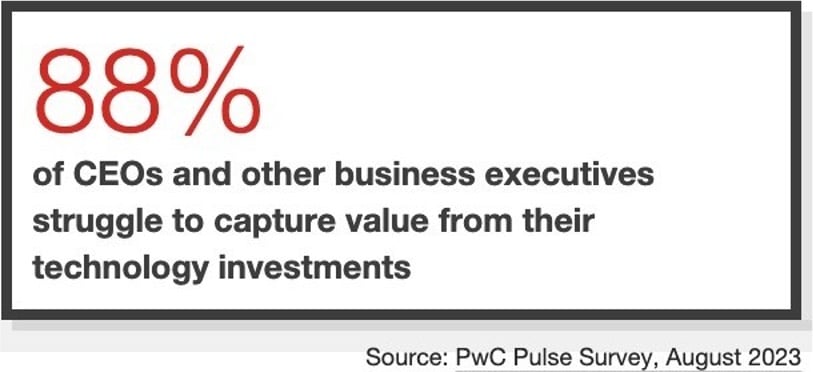For a Digital Transformation that Sticks and Sales that Grow
The rate at which your sellers adopt sales technology—or how quickly they embrace new tech tools and how deeply they integrate them into their daily selling motions—can make or break not just your revenue goals, but your B2B sales team’s quotas, your ability to retain top talent, your customer experience, and your budget.
Yet there are overwhelming tech tool requirements for sales reps. Salesforce found that B2B sales teams use an average of 10 tools to close deals, and 66% of sales reps said they’re drowning in sales tools.
What Percentage of Sales Teams Have Adopted New Technology and Tools?
At the same time, according to Outreach, the average seller adoption rate for sales tech is just 30%. And that rate doesn’t just apply to peripheral tools. Per SBI, of the 89 companies they surveyed with over $100 billion in revenue, even for top tools, adoption lags, preventing companies from gaining:
- Increased efficiency
- Better data collection
- More informed decision-making
- Improved sales strategy
- Better communication with team members and customers
- Streamlined sales funnels and processes
- Improved customer experiences and relationships
What’s Your Seller Adoption of Sales Tech Rate? Use our Sales Tech Stack Maturity Matrix to find out.
How can you overcome seller adoption roadblocks to unlock all the benefits of a strategically aligned, optimized sales tech stack? In this two-part series, we feature wisdom from MarketSource experts who are wizards behind our tech stack curtain and on the front lines with our sellers and customers.
In Part 1, Steve Bonvissuto, our head of innovation who ensures our tech empowers our sellers and helps them meet their quotas, explores the top culprits and casualties of poor seller tech adoption and offers three remedies.
In Part 2 , Cory Rossi, our innovation practice leader who audits and optimizes our customers’ sales processes to ensure they reach their goals, reveals key strategies you can deploy today to insulate your team and your sales from the harmful effects of poor seller adoption.
Top Casualties of Poor Seller Adoption of Sales Technology
Lack of sales tech adoption doesn’t just hurt sales; it has a profound ripple effect. It can thwart your digital transformation efforts, which impairs customer acquisition, existing customer satisfaction, your ability to serve customers efficiently, seller morale and talent retention.
The top 3 areas that suffer the most from obstructed seller adoption of sales tech are:
Sales Quotas. In a survey conducted by Allego, 76% of companies say poor adoption of sales tools is the main reason sellers miss their quotas. Tech should empower your sellers and work FOR them, not the other way around. Salespeople who spend too much time on tasks that could be automated or fumbling with tools whose purpose they don’t understand or that they’re not comfortable using are going to close fewer deals.
Sales Efficiency. Gartner’s recent study of 908 B2B salespeople shows that 49% feel overwhelmed by the number of tools required to complete their work, and nearly 60% reported that the introduction of new sales technologies hinders their overall efficiency. That’s because often sales technology fails to meet the detailed daily needs of salespeople—or is “enterprise-” rather than “seller-centric.” And 82% of sales leaders surveyed told Allego that trying to get reps to use the provided sales tools feels like a second job.
Sales ROI. 55% of surveyed sales professionals, including CSOs and sales operations leaders, expressed high regret from recent revenue technology purchases. And companies reported wasting an average of $313,000 over the past two years on sales tools that weren’t fully adopted by reps.
Thankfully, these aren’t inevitable realities. If you feel stuck about seller adoption, you’re not alone, and you don’t have to stay there. We’re here to help you get out of the seller adoption rut.
What’s Hurting Seller Adoption of Sales Tech?
While the configuration of causes may vary slightly by organization, the factors I see undermining seller adoption most often are:
- Over-reliance on tech as a panacea or replacement for processes that ensure sales performance
- Misalignment of tech and processes
- Lack of intentional, thorough seller onboarding and culturally embedded, consistent training
- Failure to factor in the human element that will always be part of the selling process
- No cycle of continuous improvement and innovation to ensure you have the right tech and it’s working for your sellers—not the other way around

“The biggest adoption hurdle is a mismatch between the jobs revenue leaders expect tech to accomplish and an either broken or missing underlying sales processes.” – Steve Bonvissuto, VP of Innovation, MarketSource
Companies use tech either to provide better information to the user, to make a good process better by automating it, or to streamline a process to drive efficiencies. When the tech doesn’t align with a process, it either lays bare the reality that there was no process at all or exacerbates the underlying process .
A few years ago, there were point solutions available. Now, the convergence we predicted is playing out, which has left a lot of tools in the graveyard. Organizations are abandoning them because they’re not getting the ROI they expected.
This is not a new problem, though. For decades, much of the sales tech on the market has failed to deliver an ROI, either because the hype didn’t deliver, or the process and the tech didn’t align. To be effective, tech must support an existing, effective sales process.
CIOs must build a business case to implement any technology, but the promise of their tech of choice often goes unfulfilled. If the tech you invest in isn’t set up to support a specific process, it won’t provide the benefit it was intended to. Alternatively, if the process tries to support the tech, the tech won’t work, or it will increase inefficiencies.
Three Ways to Increase Seller Adoption of Sales Technology
As an outsourced sales provider, with so much at stake for our clients, we can’t afford to have poor seller adoption, so we don’t allow it to happen. Ensuring our sellers’ comfort and success with technology is inherent to our strategy and a priority that underpins our sales ecosystem.
“As an outsourced sales provider, with so much at stake for our clients, we can’t afford to have poor seller adoption, so we don’t allow it to happen.” – Steve Bonvissuto, VP of Innovation, MarketSource
To strengthen adoption of sales tech among your sellers:
Align your tech with your sales processes.
We take an engineering approach to sales, which allows us to identify things in the sales process that don’t work—especially upstream—and to align tech with our processes. Our sales ecosystem consists of a series of flows, so if something doesn’t work early in the process, it tends to negatively impact something later in the process. Tech can’t possibly assist in this situation. So, we build the process first, then identify the ideal technology solution to optimize it. For example, coaching is a strategic priority for us—our goal is 95% adoption rate on 1:1 seller coaching. When our vendor decided to sunset our 1:1 coaching platform, we turned to our backup vendor, which led to a drop-off in 1:1 coaching. To remedy the situation, we located a vendor that enabled us to meet our seller coaching objectives and to help us deliver on the promises we’ve made to our customers.
Implement a continuous improvement process.
We use continuous improvement, a method to find incremental improvement opportunities in processes, skills, and technology, to keep seller adoption in line. It helps us make our salespeople better every single week by surfacing breaks in process so we can streamline them, and making sure they have the right information at the right time in the buying process, which helps them meet their quotas. We use continuous improvement to reduce red time (administrative) and increase green (selling) time. We make sure our tech supports a streamlined sales process, and then we optimize it. This serves the seller more effectively, which makes them not only want to use it but become reliant on it. Continuous improvement also reduces customer churn. We know how hard and expensive it is to acquire a customer, which is why we’re focused on helping our clients keep and grow them.
Let your digital transformation sales strategy guide your tech decisions.
B2B buyers are much more educated now. According to a 2023 report from 6sense, they’re usually roughly 70% through their buying journey before they even contact sales. This reality demands companies engage buyers much earlier in the process—when they’re educating themselves on the solutions to their problems—and in an omnichannel way. Done well, digitalization, which supports the way customers buy, increases customer engagement, boosts salespeople’s skills and performance, and supports a more customer-focused sales approach. But a lot of companies are struggling with digital transformation, and tech is an instrumental character in that play. Rather than investing in a technology tool and figuring out where it fits, evaluate your digital transformation priorities and select tech solutions that will help you fulfill them.
Ready to talk?
Your tech stack can be an enabler, but only if your sellers use it. Use our Sales Tech Stack Maturity Matrix™ to benchmark where you stand. If you need help taking it to the next level…

Author: Steve Bonvissuto
Steve Bonvissuto leads our innovation team to continuously improve the delivery of MarketSource services, creating more value for customers and employees. Steve consults and partners with key internal and external executives to innovate and execute strategies that enable teams to deliver additional value and exceed customer expectations. Proven engineering principles are used to streamline and improve sales processes. Steve is responsible for evaluating, piloting, and selecting emerging sales enablement technologies for increased efficiencies.
Want More Sales?
Subscribe now to receive occasional emails with insights that help you accelerate profitable growth, risk reduction, market expansion, and revenue velocity.
What are you waiting for?

